Why should I care about environments?

Environments power a lot useful things R:
R6 version of object-oriented programming (we’ll get there chapter 16 – patience)
environments power dplyr and ggplot2 (apparently)
lexical scoping (x as a value in our workspace vs x as a thing inside a function)
x = 10
toy_function = function(x, y){
print(glue::glue("Hi, I think x is {x}"))
new_value = x + y
print(glue::glue("So {x} plus {y} is {new_value}"))
}
toy_function2 = function(y){
print(glue::glue("However since I don't have an x, I look to the global and think x is {x}"))
new_value = x + y
print(glue::glue("So {x} plus {y} is {new_value}"))
}
toy_function(x = 2,y = 3)## Hi, I think x is 2
## So 2 plus 3 is 5toy_function2(y = 3)## However since I don't have an x, I look to the global and think x is 10
## So 10 plus 3 is 13So what is an environment?
- an unordered bag of bindings between names and values
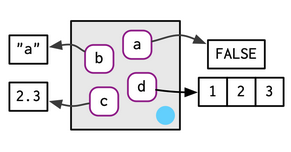
How is it different from just using a named list?
Every name must be unique. Every item must have a name
No ordering to the names (we can’t retrieve things with env[[1]])
Environments have a parent.
Environments are modified in place
library(rlang)
e1 <- rlang::env(
a = FALSE,
b = "a",
c = 2.3,
d = 1:3,
)
e1$z <- "FISH"
env_print(e1)## <environment: 0x7fb89ffc7ef0>
## parent: <environment: global>
## bindings:
## * z: <chr>
## * a: <lgl>
## * b: <chr>
## * c: <dbl>
## * d: <int>env_names(e1)## [1] "z" "a" "b" "c" "d"e2 <- rlang::env(
a = FALSE,
a = "a",
c = 2.3,
d = 1:3,
)
env_print(e2)
e2[[1]]
e1[["z"]]What kind of environments does R have?
There are 2 important ones you’ve been working with your whole time in R.
- First there’s the global environment or your workspace.
- Then there’s the current env where code is executing
x = 10
toy_function = function(x, y){
print(current_env())
print(glue::glue("Hi, I think x is {x}"))
new_value = x + y
print(glue::glue("So {x} plus {y} is {new_value}"))
}
toy_function2 = function(y){
print(current_env())
print(env_parents(current_env()))
print(glue::glue("However since I don't have an x, I look to the global and think x is {x}"))
new_value = x + y
print(glue::glue("So {x} plus {y} is {new_value}"))
}
toy_function(2,3)
toy_function2(3)
print(current_env())How did toy_function2() know to look for the x in the current_env() where x was defined?
Parents
Wait, now what’s a parent?
Every environment has a parent, which is another environment
- If you don’t set the parent, R uses the current environment
- How do we make the following relationship?
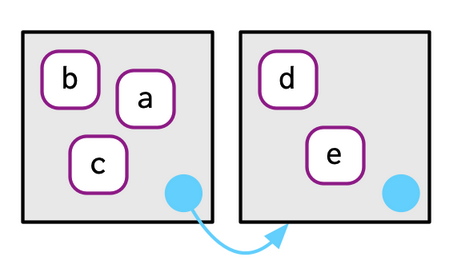
mummy_env <- env(d = 4,
e = 5)
baby_env <- env(mummy_env,
a = 1,
b = 2,
c = 3)
env_parent(baby_env)How many ancestors are there?
Everything ends in the empty environment, but when you print the ancestors of an environment R will stop at the global, we can override that if we want though
mummy_env <- env(d = 4,
e = 5)
baby_env <- env(mummy_env,
a = 1,
b = 2,
c = 3)
env_parents(baby_env)
env_parents(baby_env, last = empty_env())Special skillz
There is a special assignment tool with <<- It’s called super assignment and rather than creating a variable in the current environment it will modify an existing variable in a parent environment
x <- 0
f <- function() {
x <<- 1
}
f()
x## [1] 1mummy_env <- env(d = 4,
e = 5)
mummy_env$e
baby_env <- env(mummy_env,
a = 1,
b = 2,
e <<- 3)
mummy_env$eHow can I change the items in my bag of bindings?
e3 <- env(x = 1,
y = 2)
e3$z <- 3
# Asking for an unassigned value returns NULL
e3$xyz
#if you want an error for debugging purposes you use env_get
# env_get(e3, "xyz")
env_poke(e3, "a", 100)
env_bind(e3, a = 10, b = 20)
env_has(e3, "a")
#What do you think happens when we do this?
e3$a <- NULL
##
#
##
##
##
##
env_has(e3, "a")
env_unbind(e3, "a")What about if I want to put something in there…but fancy
There are 2 fancy bindings, env_bind_lazy() and env_bind_active()
env_bind_lazy()won’t bind until the first time the thing is accessedenv_bind_active()will re-compute every time they’re accessed (we’ll use this later in R6)
Quiz Break
- How do we make the pair of environments as illustrated by this picture.
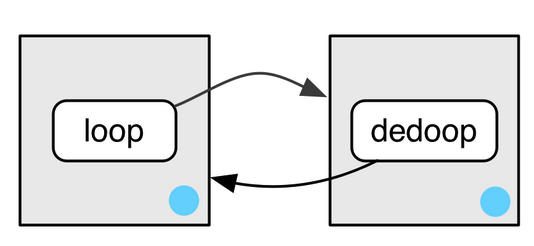
- Why don’t e[[1]] and e[c(“a”, “b”)] don’t make sense when e is an environment?
e <- env(
a = FALSE,
b = "a",
c = 2.3,
d = 1:3,
)How do packages work anyway?
Why does this fail?ggplot(mtcars) + geom_point(aes(x = disp , y = hp))And this doesn’t?
library(ggplot2)
ggplot(mtcars) + geom_point(aes(x = disp , y = hp))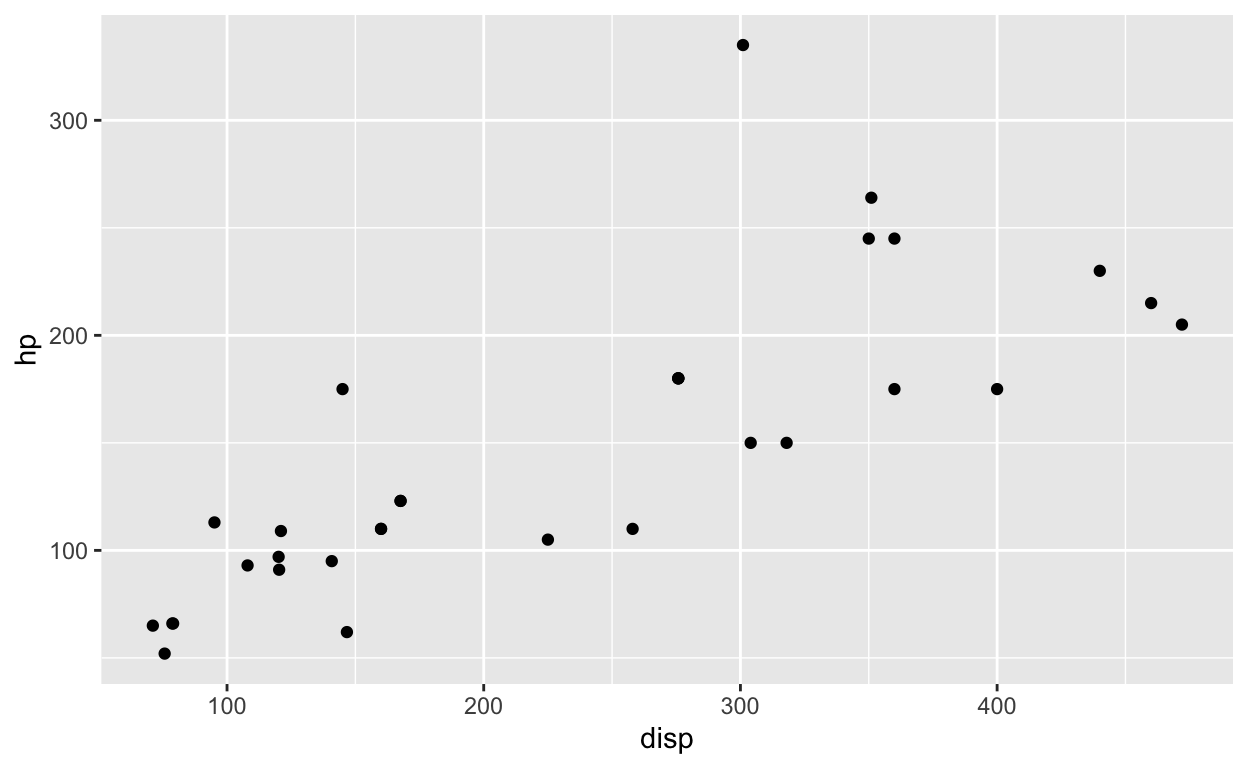
Everytime we add a package with library() or require() we’re adding to the search path
 What will happen to the
What will happen to the seach_envs() and the parent_env() of the global environment after I load cowplot?
search_envs()## [[1]] $ <env: global>
## [[2]] $ <env: package:ggplot2>
## [[3]] $ <env: package:rlang>
## [[4]] $ <env: package:learnr>
## [[5]] $ <env: package:shiny>
## [[6]] $ <env: package:stats>
## [[7]] $ <env: package:graphics>
## [[8]] $ <env: package:grDevices>
## [[9]] $ <env: package:utils>
## [[10]] $ <env: package:datasets>
## [[11]] $ <env: package:methods>
## [[12]] $ <env: Autoloads>
## [[13]] $ <env: package:base>env_parents(current_env())## [[1]] $ <env: package:ggplot2>
## [[2]] $ <env: package:rlang>
## [[3]] $ <env: package:learnr>
## [[4]] $ <env: package:shiny>
## [[5]] $ <env: package:stats>
## [[6]] $ <env: package:graphics>
## [[7]] $ <env: package:grDevices>
## [[8]] $ <env: package:utils>
## [[9]] $ <env: package:datasets>
## [[10]] $ <env: package:methods>
## [[11]] $ <env: Autoloads>
## [[12]] $ <env: package:base>
## [[13]] $ <env: empty>library(cowplot)
search_envs()## [[1]] $ <env: global>
## [[2]] $ <env: package:cowplot>
## [[3]] $ <env: package:ggplot2>
## [[4]] $ <env: package:rlang>
## [[5]] $ <env: package:learnr>
## [[6]] $ <env: package:shiny>
## [[7]] $ <env: package:stats>
## [[8]] $ <env: package:graphics>
## [[9]] $ <env: package:grDevices>
## [[10]] $ <env: package:utils>
## [[11]] $ <env: package:datasets>
## [[12]] $ <env: package:methods>
## [[13]] $ <env: Autoloads>
## [[14]] $ <env: package:base>env_parents(current_env())## [[1]] $ <env: package:cowplot>
## [[2]] $ <env: package:ggplot2>
## [[3]] $ <env: package:rlang>
## [[4]] $ <env: package:learnr>
## [[5]] $ <env: package:shiny>
## [[6]] $ <env: package:stats>
## [[7]] $ <env: package:graphics>
## [[8]] $ <env: package:grDevices>
## [[9]] $ <env: package:utils>
## [[10]] $ <env: package:datasets>
## [[11]] $ <env: package:methods>
## [[12]] $ <env: Autoloads>
## [[13]] $ <env: package:base>
## [[14]] $ <env: empty>Special Environments
the sd() function from the stats pack uses var() function, so what might happen to sd() if I define a new function var()
sd## function (x, na.rm = FALSE)
## sqrt(var(if (is.vector(x) || is.factor(x)) x else as.double(x),
## na.rm = na.rm))
## <bytecode: 0x7fb8a15874a8>
## <environment: namespace:stats>x <- sample(3,30,T)
print(sd(x))
var <- function(q,w){
#var now returns a sample of q and w
return(sample(c(q,w),1))
}
var(1,2)
print(sd(x))sd() still calls to the correct var() function because every function from a package not only comes with the package environment, but also a namespace environment
Functions use the names defined in the namespace environment.
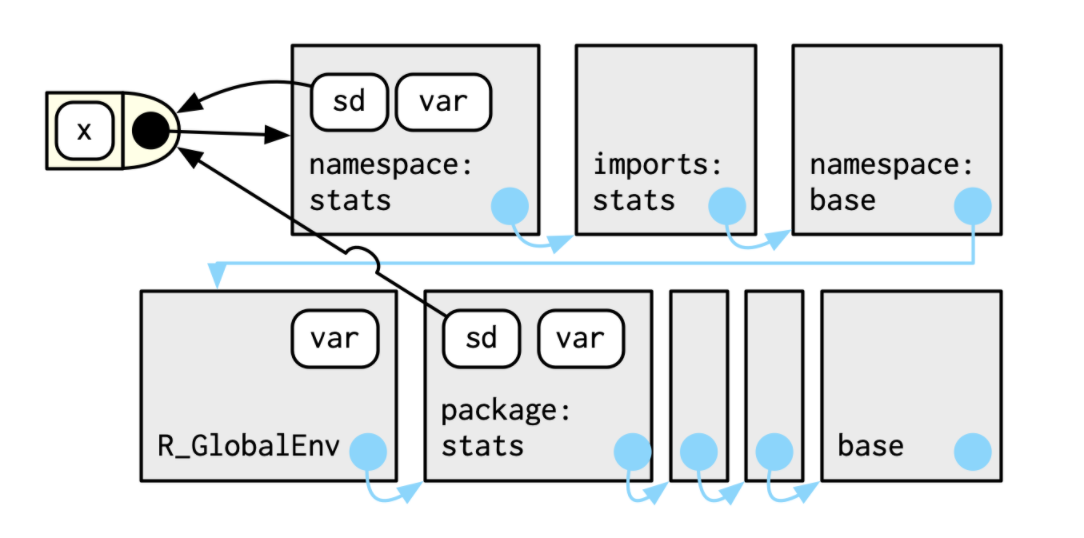
Function environments
What is the environment of toy_function?
x = 10
toy_function = function(x, y){
print(current_env())
print(glue::glue("Hi, I think x is {x}"))
new_value = x + y
print(glue::glue("So {x} plus {y} is {new_value}"))
}
print(fn_env(toy_function))
##
##
##
##
# print(current_env())The call stack
We’re used to looking at the call stack when errors occur using traceback()
f <- function(x) {
g(x = 2)
}
g <- function(x) {
h(x = 3)
}
h <- function(x) {
stop()
}
f(x = 1)
#> Error:
traceback()
#> 4: stop()
#> 3: h(x = 3)
#> 2: g(x = 2)
#> 1: f(x = 1)We can use lobstr::cst() to explore the callstack
f <- function(x) {
g(x = 2)
}
g <- function(x) {
h(x = 3)
}
h <- function(x) {
lobstr::cst()
}
f(x = 1)
#> █
#> └─f(x = 1)
#> └─g(x = 2)
#> └─h(x = 3)
#> └─lobstr::cst()P.S. this looks wild in the shiny app
f <- function(x) {
g(x = 2)
}
g <- function(x) {
h(x = 3)
}
h <- function(x) {
lobstr::cst()
}
f(x = 1)Things can get more complicated with lazy evaluation
a <- function(x) b(x)
b <- function(x) c(x)
c <- function(x) x
a(f())
#> █
#> ├─a(f())
#> │ └─b(x)
#> │ └─c(x)
#> └─f()
#> └─g(x = 2)
#> └─h(x = 3)
#> └─lobstr::cst()What are some useful ways we can use environments?
* Avoid making copies of large data sets
* Manage state within a package
* as a hashmap(or like a python dictionary)Quiz Questions!!!
* List at least three ways that an environment differs from a list.
* What is the parent of the global environment?
* What is the only environment that doesn’t have a parent?
* What is the enclosing environment of a function? Why is it important?
* How do you determine the environment from which a function was called?
* How are <- and <<- different?Quiz Answers!!!
* List at least three ways that an environment differs from a list.
every object in an environment must have a name
order doesn’t matter
environments have parents
environments have reference semantics.
* What is the parent of the global environment?
The parent of the global environment is the last package that you loaded.
* What is the only environment that doesn’t have a parent?
The only environment that doesn’t have a parent is the empty environment.
* What is the enclosing environment of a function? Why is it important?
The enclosing environment of a function is the environment where it was created.
It determines where a function looks for variables.
* How do you determine the environment from which a function was called?
`caller_env()` or `parent.frame()`
* How are <- and <<- different?
<- always creates a binding in the current environment; <<- rebinds an existing name in a parent of the current environment.